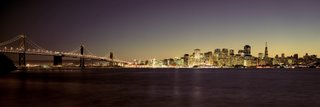One hundred years ago today, at 5:12 am, a 7.9 earthquake destroyed San Francisco and laid waste to huge swaths of the Bay Area. Buildings collapsed, trains were knocked off their tracks, and marble gravestones were snapped in half by the whiplash effect from a 3,000 mile an hour ripple. As if the devastation of the temblor weren't horrible enough, the resulting inferno destroyed much of what was left of the then biggest city in California. It is estimated that 3,000 people were killed and 250,000 were left homeless. For some perspective, the 1906 earthquake was 3,000 times stronger than the 1989 Loma Prieta earthquake, which leveled a section of the upper deck of the Bay Bridge, knocked the Cypress Street Viaduct, killed 63 people, and caused $6 billion worth of damage.
After Loma Prieta, the San Francisco government mandated that all brick buildings be retrofitted by February 2006. In the thirteen years since I moved to San Francisco, many public buildings have been closed at various times to be retrofitted: City Hall, Bill Graham Civic Auditorium, The Fillmore, etc. Most official city buildings are brick and it's these types of buildings that are most likely to fail during a big shake. They can shower masonry on the streets below and have a pancake-like collapse. To date, 75% of all masonry buildings have been retrofitted. Retrofitting these is, of course, an excellent idea, but much more needs to be done. Most residential homes in town are made of wood - my own home among them. This makes conflagration a very real threat. Many of these houses are over 70 years old and the structure is often secured to the foundation by gravity alone. This means the house can be shaken off its foundation or, frighteningly, the basement could slide out from under the house. Given that we stand a 2 in 3 chance of experiencing a major earthquake in the next 30 years, this is a huge concern. When we bought our house, we had it retrofitted. The structure was bolted to the foundation, (prevents sliding), the walls in the basement were sheer walled (mitigates twisting), and the supporting pillars were bolted to the foundation, and to the support beams (prevents the pillars from sliding). However, official statistics show that most residents haven't retrofitted their homes. Retrofitting is relatively affordable, especially when measured against the cost of replacing your house, and we were renovating anyway. Most people think they can't afford the cost, or the disruption, so they just put it on the long finger or simply ignore the danger. On top of that, the San Francisco water system, although scheduled for a massive overhaul, is ancient and crumbling. Back in 1906, the water system failed and the fire department was critically hampered in their efforts to put out the fires raging all over town. Then of course, there is securing our two most recognisable landmarks, The Golden Gate Bridge and the Bay Bridge (the Bay Bridge retrofit is underway). And we haven’t even got to schools, ports, hospitals, etc. All in all, there is a ton of work to be done.
It’s difficult to think about: that this gorgeous city will be potentially seriously damaged by a massive earthquake sometime in the coming years. Even if the city spends billions on retrofitting, gets it all finished on time, and has a bullet-proof disaster plan, it will be more to prevent deaths than to save buildings. Buildings may not fall down, but they may still be uninhabitable after a huge shake. This translates into potentially huge numbers of homeless.
Tash and I have made some efforts to be organised and have stocked up a sizeable food and water supply and a first aid kit. But we still need to get wind up lights and a wind up radio, and make it all portable at a second's notice. We also need a meet up plan for our relatives and friends. And lastly, but most importantly, we need to make sure all heavy objects in our house are secure - I got most of them secured a year back and then slacked on finishing the job. No better time than now. And if we can't get our shit together on the 100th anniversary of the 1906 earthquake - and be prepared for the inevitable sequel - one would have to question our sanity.



